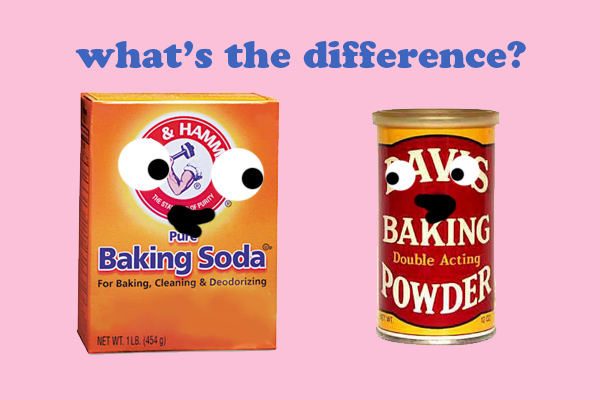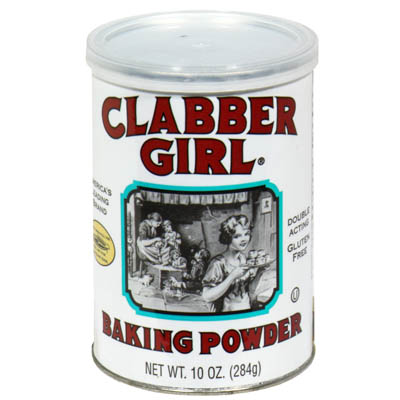What’s the difference between baking soda and baking powder? They both sound alike, they’re both white and powdery in texture, and they’re both used in baking cookies and cakes. In fact, their roles are even aligned in baking: they are both leavening agents. So why have both? As it turns out, they are activated and work in different ways–so their roles are distinct in helping you attain delicious and perfectly textured results. You can’t decorate a cake if it doesn’t bake properly, so find out the essential differences here!

Here’s a primer on how it all works.
Baking soda

What it is:
If you want to get technical, what we call baking soda is actually sodium bicarbonate or sodium hydrogen carbonate. It is found dissolved in mineral springs, and has a slightly salty, bitter taste. In terms of appearance, it is sold as a fine white powder, and generally comes packaged in a box.
How it works in baking:
Baking soda reacts with the acidic ingredients in batter. Some examples of acidic ingredients? Lemon juice, cream of tartar, buttermilk, cocoa, and vinegar. This causes a an instant reaction, and then when the batter is put in the oven, the heat causes carbon dioxide to release, causing expansion in the batter, giving it a rise, and lending a tender, light texture to cakes, quick breads, muffins, and cookies.
Note:
Because the reaction of baking soda and the acidic ingredients starts right away, you don’t want to dawdle too long with the batter or dough before you put the baked good in the oven–it may reduce the lift your baked goods attain when baked.
Baking powder

What it is:
Baking powder is actually a derivative of baking soda. It is is actually baking soda mixed with an acidic ingredient (typically cream of tartar), which means it doesn’t have to be added to an acidic ingredient in batter to work. Instead, it is activated by moisture. Because of this, often has a drying agent such as starch, too, to keep it from activating too soon. It often comes in a small, round can.
How it works:
Like baking soda, the function of baking powder is to give baked goods a nice rise. However, since it already has an acidic ingredient added, the reaction occurs not when it is combined with acid, but when it is combined with moisture and/or heat, depending on the type of baking powder you use.
There are two types of baking powder:
It is available as a single-acting baking powder, which is activated by moisture. Because the reaction starts when the powder comes into contact with moisture (usually when wet and dry ingredients are combined), it is important to bake the item in question soon after preparing the batter or dough to maintain a good rise.
Double-acting baking powder reacts when combined with moisture, but then again during the baking process. This means that it will release more gas when it comes into contact with heat in the oven, and will attain more of a rise even if the batter has been sitting for a while. This is the more readily available type of baking powder in most grocery stores.
Why do some recipes call for baking soda, whereas others call for baking powder?
Basically, it depends on what other ingredients the leavening agents will be working with.
Baking soda has a distinct flavor (if you’ve ever used toothpaste with baking soda you know it). The acidic ingredients which react it also soften the flavor. If the recipe doesn’t include an acidic ingredient and you use baking soda, you may end up with a slightly chalky, salty and bitter tasting result.
Baking powder doesn’t require the counteracting acidic ingredient since it already contains acid. So, even if a recipe does not include an acidic ingredient, the baking soda will work without imparting a bitter taste. Recipes containing neutral flavors such as milk or cream will often rely on baking powder for an unflavored lift.
What about recipes that call for both baking soda and baking powder?
Some recipes call for both baking soda and baking powder. Basically, it’s a system of checks and balances. If a recipe contains baking soda to neutralize the acid in a recipe, it might not be enough leavening to give a decent lift to the baked good, but adding more baking soda might be too much in relation to the acid. Here’s where the baking powder comes in, to save the day by giving the recipe a little extra lift while maintaining a pleasant flavor.
Can I substitute baking soda for baking powder?
Sorry…but no. Their different modes of activation are key to a recipe’s success.
While you can’t swap one for the other, you can make your own baking powder at home, using baking soda. Simply mix two parts cream of tartar with one part baking soda. Then, add a small amount of cornstarch, too–this drying agent will keep it from activating too early. Don’t forget to measure it as baking powder, not soda!
How long do baking soda and baking powder last?
Not forever. If you’re unsure about whether your baking soda is still good, perform this little at-home test, called “proofing”. Place 1/4 cup of baking soda into a cup. Now, add 1/4 cup of warm tap water and 2 tablespoons of vinegar. The mixture should bubble.
You can “proof” baking powder, too. Place 1/4 cup of baking powder in a cup. Now, pour 3 tablespoons of warm tap water on top. The mixture should bubble.

Share tips, start a discussion or ask one of our experts or other students a question.
No Responses to “Baking Powder vs. Baking Soda: Is There Just One Winner?”